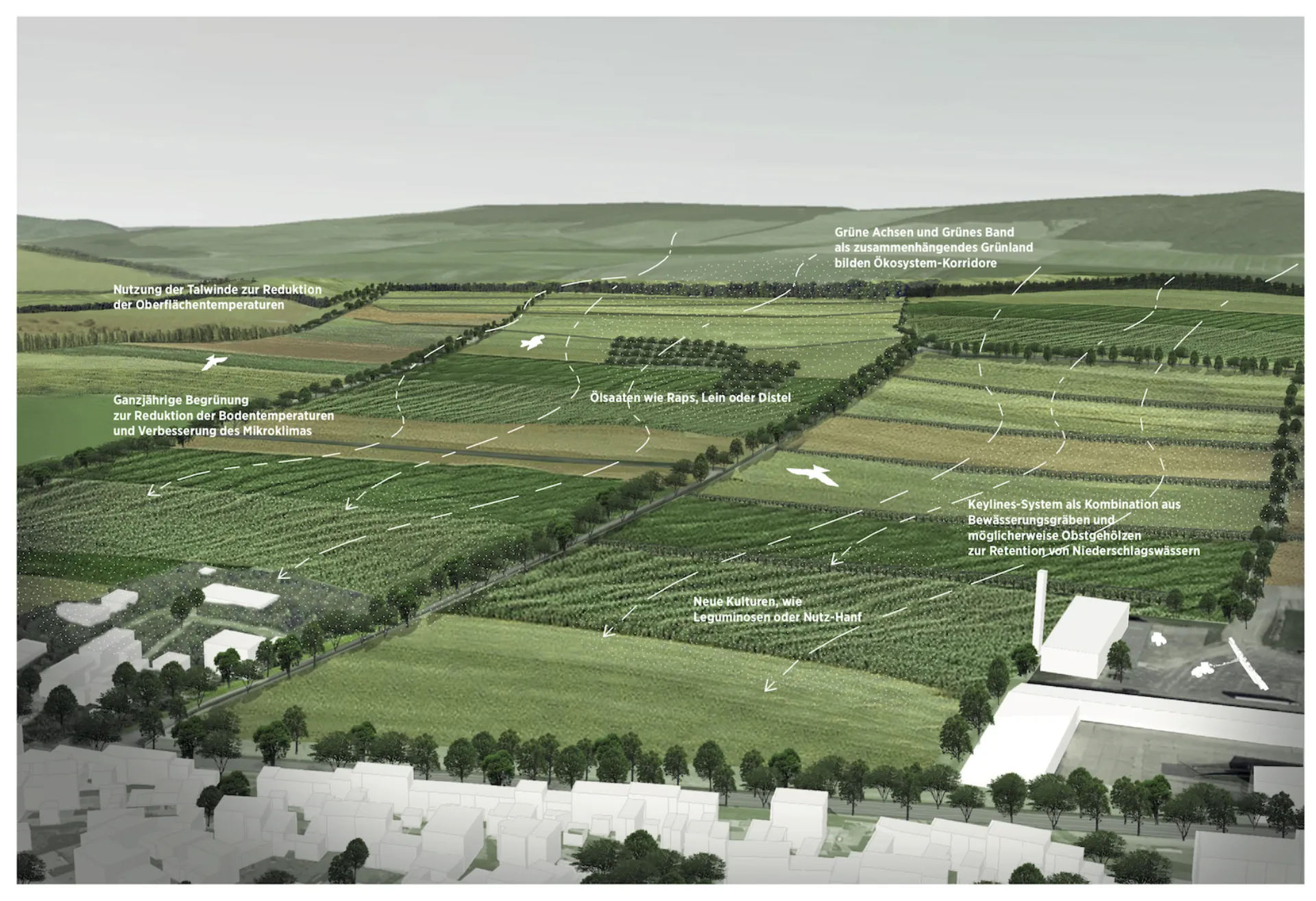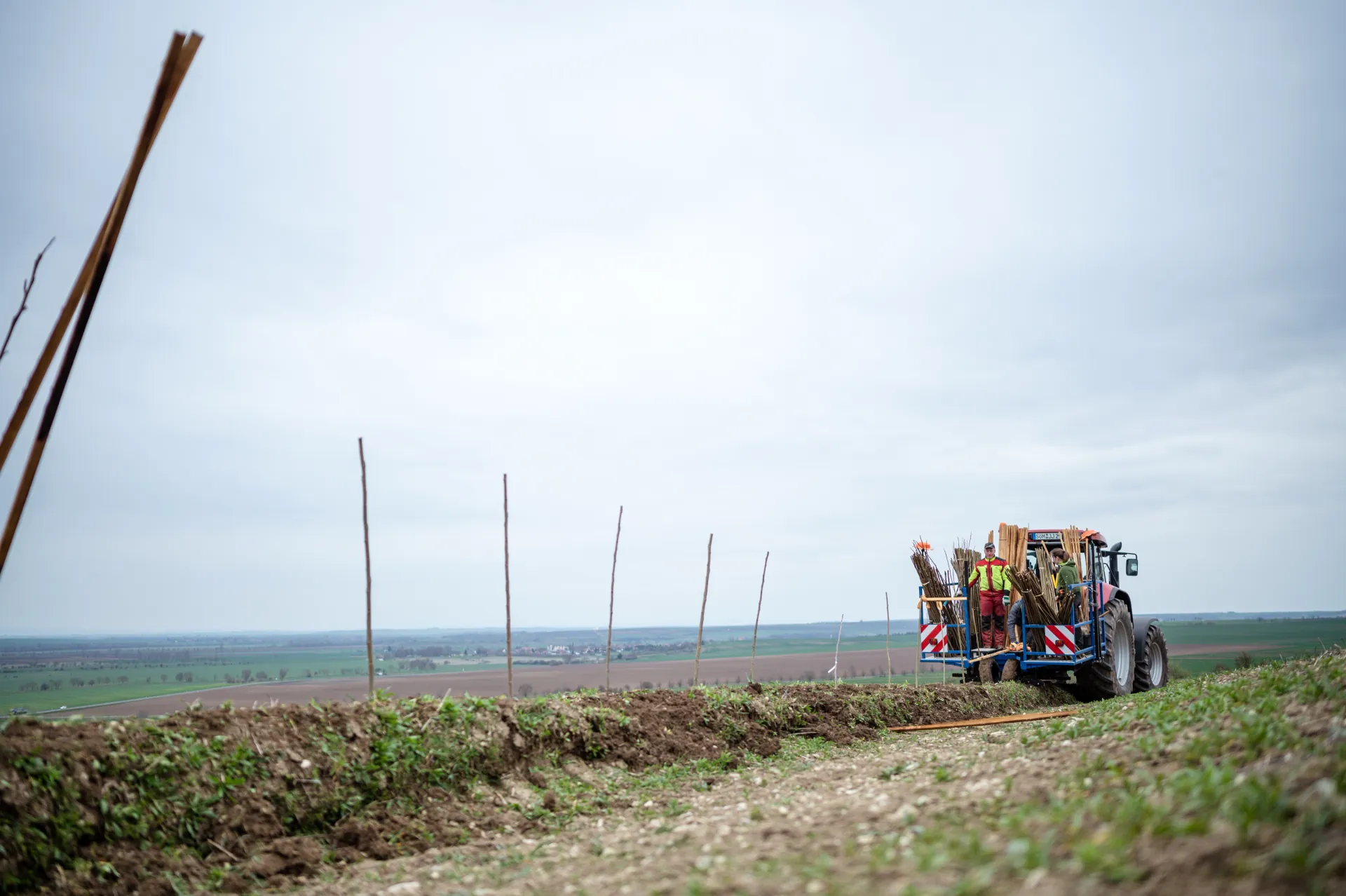project website: www.klimakulturlandschaft.de
In times of undeniable climate change, there needs to be a fundamentally new relationship between individuals and nature, settlements and open spaces, and society and resources. Against this background, what does good agriculture look like? This question is more relevant today than ever, as temperatures rise, extreme weather events increase, precipitation shifts to the winter season, and the vegetation period shifts. But not only climate change poses fundamental challenges to current practices, but also social changes and increasing dependence on global developments. A sustainable agriculture, therefore, must be thought of multidimensionally in order to adapt to changes, minimize climate damage, and remain competitive. The consequence of this multidimensional transformation process is the reassessment of our agriculture, its function, use, and actors. It is not only the farmers who are asked to act, but society as a whole.
Using the example of Kannawurf, a municipality in the Thuringian Basin, a concept for the future of agriculture was developed that considers ecological, economic, and socio-cultural strategies together. A vision for a climate-just agriculture of the 21st century has been created, which views the landscape and agriculture differently with new landscape types, cross-operational crop rotation management, and artistic interventions. Kannawurf is located in the northeast of Thuringia, in the district of Sömmerda, near the Kyffhäuser and nestled between the forested ridge of Hainleite and the river Wipper. The municipality is characterized by large-scale, intensively cultivated agricultural landscape, the small village of Kannawurf with around 800 inhabitants, and a Renaissance castle. Thus, Kannawurf is a typical municipality in the rural area of Thuringia.
To a large extent, the voluntary fire department, an active carnival association, the local farmer, the environmental group, and the new owners of the castle shape the social life in the community. In 2007, the Künstlerhaus Thüringen e. V., under the chairmanship of Roland Lange, acquired Kannawurf Castle and has been committed to its gradual restoration, the revival of the Renaissance garden, and cultural activation ever since. Furthermore, the association has been staging artistic interventions in the village and the landscape for years to promote participation and a different approach to agricultural and land management.
A summer 2017 IBA Campus was the joint starting point for Künstlerhaus and IBA Thuringia to develop new landscape descriptions. Regional self-sufficiency, the protection of rivers, forests, and meadows, and people's access to the landscape were just as important as the region's financial independence and its communal thinking and acting. With this goal in mind, the partners, together with local farmers and other actors, founded Koop Kannawurf in 2019. Together, they wanted to assess how the conventionally cultivated agricultural land in Kannawurf could be ecologically, economically, and aesthetically upgraded. The principle of sustainability and socially added value without economic losses was always at the center oft he project.
The result was a local climate-conscious vision for a climate-adapted cultural landscape of the 21st century. The landscape architects Green4Cities from Graz/Vienna developed the landscape types Aue, Kuppe, and Hang, which were identified based on their different climatic effects. Various crop rotations were developed for them to minimize wind and water erosion, heat islands, surface temperatures, and special adaptation strategies to climate change.
 The floodplain is located in the area where fresh air flows in, which allows for cooler temperatures and a more humid habitat. It is essential, therefore, to maintain and keep clear this cold air flow in the floodplain area in order to ensure important cultivation areas for high-quality crops. ©Green4Cities
The floodplain is located in the area where fresh air flows in, which allows for cooler temperatures and a more humid habitat. It is essential, therefore, to maintain and keep clear this cold air flow in the floodplain area in order to ensure important cultivation areas for high-quality crops. ©Green4Cities
 Future Klimakulturlandschaft Kannawurf. Concept and Visualisation: Green4Cities GmbH, Graz/Wien
Future Klimakulturlandschaft Kannawurf. Concept and Visualisation: Green4Cities GmbH, Graz/Wien
 Future Klimakulturlandschaft Kannawurf, Concept and visualisation: Green4Cities GmbH, Graz/Wien
Future Klimakulturlandschaft Kannawurf, Concept and visualisation: Green4Cities GmbH, Graz/Wien
A connected network of paths, referred to as the ›Green Belt‹, with new and revived connections between villages that cater to the needs of pedestrians and cyclists, provides initial accessibility. After all, only those who are familiar with the landscape can develop a critical awareness of its use and management, and come to appreciate it (again). This can be achieved through deliberate land management and the experience of it. The route of the Green Belt is designed to protect primarily erosion-prone and ecologically valuable areas such as wetlands, thereby also serving soil and water conservation.
In addition, the vision demonstrates, through inter-farm crop rotation management, how a cooperative agricultural production between farmers and processors could work. If crop rotation is not only managed within the farm but also extended to many other agricultural businesses in the region, despite smaller acreage per crop, larger quantities can be guaranteed for buyers. This reduces the investment risk for farmers because they can start with smaller plots and provides buyers with more security through stable deliveries. A sustainable whole can be created from the sum of the small parts.
Since 2021, the Künstlerhaus Thüringen has started implementing various landscape elements and planted about 1,600 new trees and created several kilometers of hedges in the wetlands and on the slopes. Since 2022, Philipp Gerhardt of Deutsche Agroforst GmbH, on behalf of Koop Kannawurf, has been creating ›keyline structures‹ on an eight-hectare trial field owned by Landwirtschaft Kannawurf Betriebsgesellschaft GmbH. Keylines are infiltration ditches or cultivation patterns that collect, redistribute and sustainably supply water to areas with a slight slope and a designated direction. Trees of various species along the grooves should enhance the effect and stabilize the soil. A study by Tractebel Hydroprojekt GmbH showed a reduction in soil erosion of up to 60 percent. When implemented on a larger scale, entire landscapes can be cooled, increasing the likelihood of rainfall.
As part of IBA Thuringia, the various keylines will be examined and their impact documented until the end of 2023. The results will be published on klimakulturlandschaft.de.
 In March 2023, the first poplars and walnuts were planted along the keylines..
In March 2023, the first poplars and walnuts were planted along the keylines..
Location
06578 Kannawurf
Project Sponsors Koop Kannawurf I / 2019-2021
- Internationale Bauausstellung Thüringen GmbH mit Künstlerhaus Thüringen e. V.
- Landwirtschaft Kannawurf Betriebsgesellschaft mbH
- Agrar GmbH Oldisleben
Promotion / 2019-2021
- Förderung im Rahmen der Zusammenarbeit in der Land-, Forst- und Ernährungswirtschaft durch den Europäischen Landwirtschaftsfonds für die Entwicklung des ländlichen Raums: Hier investiert Europa in die ländlichen Gebiete und den Freistaat Thüringen
- Internationale Bauausstellung Thüringen GmbH
Project Sponsors Koop Kannawurf II / 2021-2023
Promotion / 2021-2023
- Förderung im Rahmen der Zusammenarbeit in der Land-, Forst- und Ernährungswirtschaft durch den Europäischen Landwirtschaftsfonds für die Entwicklung des ländlichen Raums: Hier investiert Europa in die ländlichen Gebiete und den Freistaat Thüringen, Teilmaßnahme A — Tätigkeit von operationellen Gruppen der Europäischen Innovationspartnerschaft ›Landwirtschaftliche Produktivität und Nachhaltigkeit‹
- Internationale Bauausstellung Thüringen GmbH
Support Project Launch
IBA Campus Team 2017
IBA Project Manager
Kerstin Faber
Projektprozess
Klimakulturlandschaft Kannawurf im IBA Finale 2023
01.03.23
...
IBA Fachbeirat empfiehlt Projektstatus für ›Klimakulturlandschaft‹
02.09.22
...
Werkstattgespräch ›Zukunft Landwirtschaft‹
14.09.20
...
Leitbild für eine neue, klimagerechte Kulturlandschaft Kannawurf
10.03.20
...
EU Förderung für den Acker der Zukunft
01.01.19
...
Landwirtschaft in Thüringen: Innovation statt Nostalgie
06.07.17
...
IBA Campus entwickelt vier Szenarien für die Kulturlandschaft des 21. Jahrhunderts
06.07.17
...
IBA Fachbeirat empfiehlt Kandidatenstatus für ›Klimakulturlandschaft‹
24.09.16
...
Im Drupal zeigen